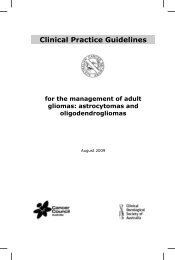Clinical Practice Guidelines for the management of locally advanced ...
Clinical Practice Guidelines for the management of locally advanced ...
Clinical Practice Guidelines for the management of locally advanced ...
You also want an ePaper? Increase the reach of your titles
YUMPU automatically turns print PDFs into web optimized ePapers that Google loves.
Lymph nodes Small, generally pea-sized pieces <strong>of</strong> tissue found all over <strong>the</strong> body but<br />
easier to feel in <strong>the</strong> neck, armpits, and groins. Lymph nodes act as filters<br />
<strong>for</strong> <strong>for</strong>eign substances and commonly become inflamed if <strong>the</strong>re is an<br />
infection nearby. They can also harbour cancer cells that have spread<br />
from elsewhere.<br />
Malignant Cancerous.<br />
Margin-positive See Surgical margins.<br />
Maximal androgen<br />
blockade<br />
Ano<strong>the</strong>r term <strong>for</strong> combined androgen blockade (CAB).<br />
Medical oncologist A specialist in <strong>the</strong> treatment <strong>of</strong> cancer who uses chemo<strong>the</strong>rapy.<br />
Metastasis The secondary or distant spread <strong>of</strong> cancer, away from its primary (initial)<br />
site in <strong>the</strong> body.<br />
Metastatic Relating to secondary cancer.<br />
Monitoring The process in which patients are followed up after initial diagnosis and<br />
treatment. Monitoring may include clinical examination and/or <strong>the</strong><br />
regular per<strong>for</strong>mance <strong>of</strong> tests.<br />
Magnetic resonance<br />
imaging (MRI)<br />
Nodules Small lumps.<br />
A way <strong>of</strong> imaging <strong>the</strong> inside <strong>of</strong> <strong>the</strong> body using magnetic <strong>for</strong>ces and<br />
without using x-rays.<br />
Oncologist A specialist in <strong>the</strong> treatment <strong>of</strong> cancer.<br />
Orchidectomy (also<br />
orchiectomy)<br />
Partial remission (or<br />
response)<br />
A type <strong>of</strong> operation which removes <strong>the</strong> testicles, but usually leaves <strong>the</strong><br />
scrotal sac or scrotum.<br />
The situation when, following treatment, signs <strong>of</strong> <strong>the</strong> disease process<br />
have partially resolved but have not disappeared completely.<br />
Pelvis/pelvic The area <strong>of</strong> <strong>the</strong> body below <strong>the</strong> waist and surrounded by <strong>the</strong> hip and<br />
pubic bones.<br />
Pituitary Part <strong>of</strong> <strong>the</strong> brain which produces <strong>the</strong> hormones that stimulate <strong>the</strong> testicles<br />
to produce testosterone (male hormone) and o<strong>the</strong>r hormones.<br />
Primary The site where <strong>the</strong> cancer began.<br />
Prognosis The course and likely outcome <strong>of</strong> a disease, as estimated by a person’s<br />
doctor or treatment team.<br />
Prostatectomy An operation to remove all or part <strong>of</strong> <strong>the</strong> prostate.<br />
Prostatitis Inflammation <strong>of</strong> <strong>the</strong> prostate. It can be caused by bacteria.<br />
Protocol A well-defined program <strong>for</strong> treatment.<br />
Prostate specific antigen<br />
(PSA )<br />
139<br />
Appendices<br />
A protein produced by <strong>the</strong> cells in <strong>the</strong> prostate, which is usually found in<br />
<strong>the</strong> blood in larger amounts when prostate cancer is present. It can be<br />
used as a test <strong>for</strong> prostate cancer or to monitor its recurrence.



